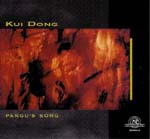Like other Chinese composers of her generation, Kui Dong (b. 1966) arrived in the United States (1991) with degrees from Beijing Conservatory but with very limited knowledge of recent Western classical music. She began working intensely at Stanford University to absorb newer musical ideas and assimilate them into her Chinese musical training. This disc includes five intriguing pieces that mix Chinese and European-based classical styles in varying proportions. At least three of them are reasonably successful.
Judging from this release, Kui’s strongest interest is in musical colors and textures and less in Western concepts of melody and motivic development. The five pieces on the disc suggest collages of sound rather than integrated formal structures. The sparest and simplest work, Pangu’s Song, for flute (both alto and standard) and percussion, also is the most memorable. Its generally pensive mood is interrupted by moments of forceful drumming. Another fine piece, Blue Melody, is for a mixed quintet of two woodwinds, two strings, and piano and is notable for its Western-style ideas that proceed in a Chinese-like heterophony–strands of similar melody playing against each other but not often synchronizing.
Earth, Water, Wood, Metal, Fire is a piano suite with each of its five movements devoted to one of these traditional Chinese elements. Kui deals with West Coast minimalism here. Note-cell repetition abounds, though with more frequent changes than you would find in “classical” minimalism. Two of the movements utlilize Cage-like preparation of the piano. Three Voices is a Western-style trio for three Chinese instruments: er-hu (fiddle), zheng (zither), and di (bamboo flute). I found this piece harmonically bitter and rather harder to assimilate than the rest. Crossing, an electronic/computer-tape work, is the longest and most colorful composition–and also the most poorly organized. Musically it comes to a halt about four minutes before its end with a section for (Chinese) spoken voices alone.
Twelve different musicians are credited with participating in the recording, none appearing on more than one piece. They all give fluent, assured, sincerely felt readings. The recording serves the varied timbres and combinations of instruments very well. The disc is recommended especially to listeners who like to explore talented newer compositional voices.
































